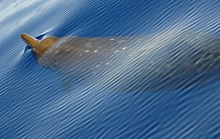Blainville's beaked whale
| Blainville's beaked whale | |
|---|---|
 |
|
 |
|
| Size compared to an average human | |
| Scientific classification | |
| Kingdom: | Animalia |
| Phylum: | Chordata |
| Class: | Mammalia |
| Order: | Artiodactyla |
| Infraorder: | Cetacea |
| Family: | Ziphiidae |
| Genus: | Mesoplodon |
| Species: | M. densirostris |
| Binomial name | |
|
Mesoplodon densirostris Blainville, 1817 |
|
 |
|
| Blainville's beaked whale range | |
Blainville's beaked whale (Mesoplodon densirostris), or the dense-beaked whale, is the widest ranging mesoplodont whale and perhaps the most documented. The French zoologist Henri de Blainville first described the species in 1817 from a small piece of jaw — the heaviest bone he had ever come across — which resulted in the name densirostris (Latin for "dense beak"). Off the northeastern Bahamas, the animals are particularly well documented, and a photo identification project started sometime after 2002.
Blainville named the species Delphinus densirostris, based on the description of a nine-inch piece of rostrum of unknown origin housed in the Paris Museum. The second specimen, a complete skull sent from the Seychelles by a M. Leduc in 1839, was named Ziphius seychellensis by the English zoologist John Edward Gray in 1846; the French scientist Paul Gervais later placed this specimen in the genus Dioplodon ("two-toothed").
The body of Blainville's beaked whale is robust, but also somewhat compressed laterally compared with other mesoplodonts. The males have a highly distinctive appearance, the jaws overarch the rostrum, like a handful of other species, but does it towards the beginning of the mandible and then sloped down into a moderately long beak. Before the jaw sloped down, a forward-facing, barnacle infested tooth is present. One of the more remarkable features of the whale is the extremely dense bones in the rostrum, which have a higher density and mechanical stiffness than any other bone yet measured. At present, the function of these bones is unknown, as the surrounding fat and the brittleness of the bone make it unlikely to be used for fighting. It has been suggested that it may play a role in echolocation or as ballast, but without sufficient behavioral observation, this cannot be confirmed. The melon of the whale is flat and hardly noticeable. Coloration is dark blue/gray on top and lighter gray on the bottom, and the head is normally brownish. Males have scars and cookie cutter shark bites typical of the genus. Males reach at least 4.4 m (14 ft 5 in) and 800 kg (1,800 lb), whereas females reach at least 4.6 m (15') and 1 tonne (2200 pounds). Juveniles are 1.9 m (6 ft 3 in) long when born and weigh 60 kg (130 lb).
...
Wikipedia

